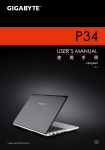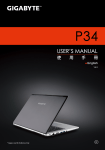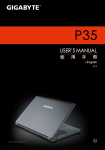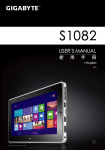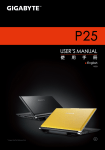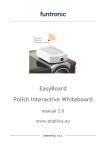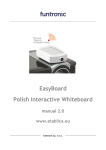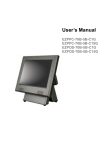Download Gigabyte P35K
Transcript
Congratulations on your purchase of the GIGABYTE Notebook. Using GIGABYTE Notebook for the First Time 3 2 1 1 Connect the power cord to the AC adapter. 2 Connect the AC adapter to the DC-in jack on the right side of the notebook. 3 Connect the power cord to the power outlet. Switching on the Power After you turn on the Notebook for the very first time, do not turn it off until the operating system has been configured. Please note that the volume for the audio will not function until Windows® Setup has completed. Booting Up the Notebook for the First Time Depending on your configuration, the Microsoft® Windows® Boot Screen will be the first screen that you will see as the notebook starts up. Follow the on-screen prompts and instructions and enter your personal information to complete the setup of the Windows® Operating System. English This manual will help you to get started with setting up your notebook. The final product configuration depends on the model at the point of your purchase. GIGABYTE reserves the right to amend without prior notice. For more detailed information, please visit our website at www.gigabyte.com 1 English 2 Your GIGABYTE Notebook Tour Top View & Front View 2 1 3 4 5 1 Webcam Status LED Indicator 2 Webcam 3 Light sensor 4 Microphone 5 Power Button 6 TouchPad 7 LED Indicators 8 Swappable Storage Bay 9 Power Check Button 6 Bluetooth Status LED Wireless Lan Status LED HDD Status LED Battery Status LED Power Status LED 7 8 9 Left View 4 1 2 3 5 6 1 Kensington Lock Slot 2 Ethernet Port 3 USB 2.0 Port 4 Headphone Jack 5 Microphone Jack 6 SD Card Reader 3 English Right View 2 1 3 4 5 6 1 Thunderbolt Port (optional) 2 USB 3.0 Port 3 USB 3.0 Port (USB Charge) 4 HDMI Port 5 External Display (VGA) Port 6 DC-in Jack 1 Memory Compartment 2 Subwoofer 3 Speakers Base View 1 2 3 English 4 Hotkeys The computer employs hotkeys or key combinations to access most of the computer’s controls like screen brightness and volume output. To activate hotkeys, press and hold the <Fn> key before pressing the other key in the hotkey combination. Hotkey Fn+ESC Fn+F1 Fn+F2 Fn+F3 Fn+F4 Fn+F5 Fn+F6 Fn+F7 Fn+F8 Fn+F9 Fn+F10 Fn+F11 Fn+F12 Fn+Space Function Description Eject ODD Eject ODD Sleep Put the computer in Sleep mode. Wireless LAN Enables/disable the Wireless LAN function. Brightness Down Decrease the screen brightness. Brightness Up Increase the screen brightness. Display Toggle Switche display output between the display screen, external monitor (if connected) and both. Touchpad Toggle Turn the internal touchpad on and off. Speaker Toggle Turn the speaker on and off. Volume Down Decrease the sound volume. Volume Up Increase the sound volume. Screen Display Toggle Turn the screen display on and off. Bluetooth Enable/disable the Bluetooth function. Webcam Turn the internal webcam on and off. Keyboard Backlight Toggle Turn the keyboard backlight on and off. 5 Swappable bay Application English 2 1 Unlock swappable bay locker. 2 Draw the swappable bay out. 1 9.5mm HDD/SSD only Connect the HDD or SSD pin by sliding it into the connecter. English 6 Gently push the plastic frame outwards. Slide in the HDD or SSD until it locks into place. There will be a slight click. 1 1 Pull swappable bay back to slot. 2 Lock swappable bay locker. 2 Setup Your System for RAID 0/1 ●● RAID 1 needs two storage drives of the same specification and capacity in your laptop. ●● R AID 0 needs two storage drives of the same specification in your laptop. Different capacity is acceptable. 1 • Press F2 when computer starts to Enter BIOS setup utility. • Go to Advanced > SATA configuration. 2 • Change "SATA Mode selection" from "AHCI" to "RAID". • Press F10 to save and exit. The system will restart automatically. 3 • Once the system restarts. Go to "All Apps" found at the bottom of the screen on Windows 8 and execute Intel Rapid Storage program. 4 • Yo u w i l l s e e t h e I n t e l R a p i d S t o r a g e Technology Screen, Click> Create. 5 • Under Select Volume Type choose Optimized disc performance (RAID 0/1), Click > NEXT. • Under Configure Volume you may set Name to your preferred name and select both controllers. • Click > Next. You will see Confirm Volume Creation. Click > Create volume. • Wait until the system migration is complete and restart the laptop. English WARNING ●● Please backup your data before you build and run RAID 0/1 on your system. 7 English 8 Build a Recovery Image USB WARNING ●● S ince the default system set up on your notebook is RAID 0/1, you will need this utility to build a recovery USB in order to recover your laptop and undo RAID settings. ●● R ecovery USB will recover your notebook to factory default settings. Please backup your data before recovering your system through the recovery USB. ●● Please do not unplug power cord or turn off the power during the process of system recovery. 1 >20G 2 • You must use a minimum 20GB capacity USB to build a Recovery Image USB. Plug the USB into the laptop you would like to run the Smart Recovery on. • I n s e r t t h e D r i ve r di s c . Ru n t h e S m a r t Recover y Generator. (For without ODD model, please use external USB ODD) 3 • Select your language. 4 •Execute SmartRecoveryGenerator. 5 • Select your device from the drop down menu available under Removable Storage List. Click > Create an Image. 6 • Wait until the Ready window pops up. Now the Image is ready in your Recovery USB. • If you need to run system recovery in the future, please boot up your computer with this "recovery USB". To do that, press F12 when computer starts, choose your USB as a boot device and wait until the system restarts and takes you to the Windows 8 Screen. • It may take more than thirty minutes to run the System Recovery. GIGABYTE Software Application Smart Manager You can activate GIGABYTE Smart Manager by double clicking on the shortcut icon on the desktop if the machine you purchased has the operation system built-in. GIGABYTE Smart Manager is an icon-based control interface, enabling users to intuitionally access common system setup as well as GIGABYTE exclusive utilities. Please be noted that the GIGABYTE Smart Manager interface, icons, utilities and software versions may vary based on the purchased models. Please operate GIGABYTE Smart Manager according to the actual version built-in. Recovery Guide System Recovery (Restore your laptop operating system) When something is going wrong with the laptop operating system, the storage of the laptop has a hidden partition containing a full back up image of the operating system that can be used to restore the system to factory default settings. Note ˙˙If the storage has been switched or the partition deleted, the recovery option will no longer be available and a recovery service will be needed. ˙˙The recovery function is only available on devices with O/S preinstalled. Devices with DOS do not have the recovery function. Launch System Recovery The system recovery feature is preinstalled before the laptop is shipped from the factory. The option menu allows you to launch the Windows recovery tool to reinstall the operating system to factory default. The brief introduction below will show you how to start the recovery tool and restore your system. All ready to go Make sure your PC is plugged in. This will take a few minutes. Windows 7 Recovery Guide 1 2 Turn off and restart the laptop. During the laptop turn on process, press and hold F9 key to launch the tool. English GIGABYTE 9 English 10 The recovery will be activated and you will see the option buttons on the window. Click on “Recovery” to start it. 3 Caution O nce the “Recovery” is selected, your personal data and files will be deleted after the laptop starts restoring, and the operating system will be reset to factory default settings. 4 A progress indicator bar will show on the window when the recovery process is running. Please make sure the AC-adapter is plugged in and do not turn off the laptop. 5 Reboot the laptop after the system recovery is complete. Windows 8 Recovery Guide 1 Turn off and restart the laptop. 2 During the laptop turn on process, press and hold F9 key to launch the tool. 3 Choose your keyboard layout. You can press “See more keyboard layouts” to see next page of languages. 11 Choose “Troubleshoot” to enter the recovery settings. (Also you can choose “Continue” to exit recovery system and continue to Windows 8 for files or data backup.) There are two options for system recovery. ˙˙Refresh your PC You can refresh your laptop to improve the system stability without losing your files. ˙˙Reset your PC If you want to remove all of your files, you can reset your PC completely. Caution: All personal data and files will be lost. 5 ▓▓ Choose “Refresh your PC” [Click on “Next”] > [Choose a target operating system.] > [Click on “Windows 8”.] > [Click on “Refresh” to execute recovery function.] Here are what will happen ˙˙Your files and personalization settings won’t be changed. ˙˙Your PC settings will be restored to factory default settings. ˙˙Apps from Windows Store will be kept. ˙˙Apps you installed from discs or websites will be removed. ˙˙A list of removed apps will be saved on your desktop. ▓▓ Choose “Reset your PC” [Click on “Next”] > [Choose a target operating system.] > [Click on “Windows 8”.] > [Choose an option to recover your system] Just remove my files Only personal data and files will be removed, but computer settings will be kept. Fully clean the drive The drive will be completely restored to factory default settings. It takes more time. > [Click on “Reset” to execute recovery function.] Here are what will happen ˙˙All of your personal files and apps will be removed. ˙˙Your PC settings will be restored to factory default settings. English 4 English 12 Remark Advanced options System Restore Use a restore point recorded on your PC to restore Windows. System Image Recovery Recover Windows using a specific system image file. Automatic Repair Fix problems that keep Windows from loading. Command Prompt Use the Command Prompt for advanced trobleshooting. UEFI Firmware Settings Change settings in your PC’s UEFI firmware. Appendix Warranty & Service: Warranty and service and related information please refer to the warranty card or GIGABYTE service website as the below link: http://www.gigabyte.com/support-downloads/technical-support.aspx FAQ: FAQ (Frequent Asked Questions) please refer to the below link: http://www.gigabyte.com/support-downloads/faq.aspx













